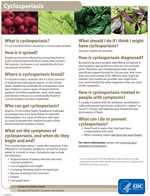U.S. Foodborne Outbreaks of Cyclosporiasis—2000–2015
Foodborne outbreaks of cyclosporiasis have been reported in the United States since the mid-1990s and have been linked to various types of imported fresh produce, including raspberries, basil, snow peas, mesclun lettuce, and cilantro; no commercially frozen produce has been implicated to date. U.S. foodborne outbreaks of cyclosporiasis that occurred before 2000 were summarized previously, as were the major documented outbreaks in 2013 and 2014. Foodborne outbreaks during the 16-year period of 2000–2015 are summarized here.
The table provides information about 32 reported foodborne outbreaks of cyclosporiasis that occurred in the United States during 2000–2015; the total case count was 1,652. No outbreaks were reported in 2003, 2007, or 2010. Overall, a median of two outbreaks were reported per year, with a median of 21 cases per outbreak (range, 3 to 582 cases). Although the outbreaks occurred during 8 different months (December through July), the peak months were May, June, and July. As indicated in the table, a food vehicle of infection was identified for 14 of the 32 outbreaks.
Identifying the particular food item/ingredient that caused an outbreak of cyclosporiasis can be very challenging—for example, if fresh produce was served as a garnish or topping or if several types of produce were mixed together. CDC and other agencies are working to develop DNA fingerprinting methods that could distinguish among different strains of the parasite Cyclospora cayetanensis that causes cyclosporiasis. In the future, such tools could help link cases of cyclosporiasis to each other and to particular types of produce, which could help public health officials investigate and prevent cases and outbreaks of Cyclospora infection.
| Table: Summary of U.S. foodborne outbreaks of cyclosporiasis, 2000–2015 | ||||
| Year(s)* | Month(s)* | Jurisdiction(s)* | No. of cases† | Food vehicle and source, if identified‡ |
| 2000 | May | Georgia | 19 | Raspberries and/or blackberries (suspected) |
| 2000 | June | Pennsylvania | 54 | Raspberries |
| 2001 | January–February | Florida | 39 | |
| 2001 | January | New York City | 3 | |
| 2001–02 | December–January | Vermont | 22 | Raspberries (likely) |
| 2002 | April–May | Massachusetts | 8 | |
| 2002 | June | New York | 14 | |
| 2004 | February | Texas | 38 | |
| 2004 | February | Illinois | 57 | Basil (likely) |
| 2004 | May | Tennessee | 12 | |
| 2004 | May–June | Pennsylvania | 96 | Snow peas from Guatemala ⁂ |
| 2005 | March–May | Florida | 582 ¶ | Basil from Peru |
| 2005 | May | South Carolina | 6 | |
| 2005 | April | Massachusetts | 58 | |
| 2005 | May | Massachusetts | 16 | |
| 2005 | June | Connecticut | 30 | Basil (suspected) |
| 2006 | June | Minnesota | 14 | |
| 2006 | June | New York | 20 | |
| 2006 | July | Georgia | 3 | |
| 2008 | March | Wisconsin | 4 | Sugar snap peas (likely) ⁂ |
| 2008 | July | California | 45 ¶ | Raspberries and/or blackberries (likely) |
| 2009 | June | District of Columbia | 34 | |
| 2011 | June | Florida | 12 | |
| 2011 | July | Georgia | 100 | |
| 2012 | June–July | Texas | 16 | |
| 2013** | June | Iowa and Nebraska | 161 | Bagged salad mix from Mexico |
| 2013** | June–July | Texas | 38 | Cilantro from Mexico |
| 2013 | July | Wisconsin | 8 | Berry salad (suspected) |
| 2014 | June | Michigan | 14 | |
| 2014†† | June–July | Texas | 26 | Cilantro from Mexico |
| 2014 | July | South Carolina | 13 | |
| 2015 | May–July | Georgia, Texas, and Wisconsin | 90 | Cilantro from Mexico |
FOOTNOTES
* The entries in the first three columns refer to the known or likely year(s), month(s), and
jurisdiction(s) in which the exposure(s) to Cyclospora occurred.
† The case counts include laboratory-confirmed and probable cases of cyclosporiasis. By definition, each outbreak included at least two linked cases, at least one of which was laboratory confirmed.
‡ A food vehicle is specified only if a single ingredient or commodity was identified in an outbreak investigation.
¶ Cases that occurred in Canadian travelers to the United States were not included.
** For additional details, see summary information about the outbreak investigations in 2013. For the purposes of this table, the exposure month(s) and case counts are limited to those explicitly linked in the investigations to the food item specified in the last column.
†† For additional perspective, see summary information about outbreak investigations in 2014. For the purposes of this table, the exposure months and the case count for the outbreak in Texas are limited to those explicitly linked in the investigations to the food item specified in the last column.
⁂ More information to help distinguish among types of peas can be found here.
- Page last reviewed: March 16, 2017
- Page last updated: March 28, 2017
- Content source:



 ShareCompartir
ShareCompartir